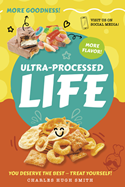A Healthy Haute Cuisine One-Dish Meal in 20 Minutes
One pan, one knife, one burner, and nearly infinite variety. If this is "poor," give me another serving, please.
A week doesn't go by without another account about how poor people can't afford healthy food and they don't have time to prepare home-cooked meals. The lack of a range/oven also seems to doom them to fast-food and the resulting illness/early death.
Just recently I read a story in which a single parent was bemoaning her inability to shop at Whole Foods (due to her low income) and her 12-hour days, and these factors apparently justified feeding her family frozen burritos and fast-food.
Many of us, poor or simply not-wealthy, work 12-hour days six days a week and we can't afford to shop at Whole Paycheck, oops I mean Whole Foods, either. In other words, the challenges of preparing healthy home-cooked meals are nearly universal.
We also read that poor people don't have easy access to supermarkets, so they are forced to buy Pop-Tarts and other junk food at the corner liquor store.
In multi-ethnic America, this account simply doesn't ring true, because "poor" neighborhoods are precisely where ethnic groceries are located: Hispanic, Asian and halal groceries abound in every ethnically diverse city and town, i.e. virtually every city/town in America. I have found ethnic markets in small towns in Iowa, for example.
We shop almost exclusively at ethnic markets in "poor" neighborhoods, because the quality and price are superior. You want quality chicken? Shop at a halal. You want quality fresh vegetables at reasonable prices? Shop at an Asian or Hispanic market. These markets are generally quite competitive, and they buy their produce carefully because their customers are picky about price and quality.
Not only that, shopping at these local ethnic markets is fun and interesting. You can learn a lot by asking questions and being observant. A smile goes a long way and pretty soon you'll be welcomed as a regular.
The narrative that only having a cooktop dooms you to junk food is also false. All anyone needs is one source of heat and a cheap wok to make an essentially limitless array of fine cuisine that rivals the fanciest restaurant fare.
The fast-food/junk food diet enables the frazzled adult to rush home and turn on the TV or Facebook--both of which are completely deranging. The more exhausted one feels, the more important it is to slow down, focus on the present and engage in a calming activity that generates right mindfulness and positive feelings--like cooking a meal.
Yes, I watch TV and have a Facebook account, just like I drink wine or beer--in moderation, and with strict limits (15 minutes of social media once a day works for me--and my email program is closed most of the day, too). This is the only way to avoid being completely deranged by media, messaging and social media.
So when I'm frazzled at the end of a long and trying day, here's a quick, healthy meal that's as good as any fancy restaurant fare. If some hot-shot TV chef showed up at our house, I would make him/her this dish absolutely confident it would meet every standard of excellence. In haute cuisine (East and West), this would include a balance of contrasting tastes, textures, colors and mouth-feel.
In Asian cuisine, meat (or vegetarian equivalents such as pressed tofu) is a condiment, not the main ingredient. In this case, I used a few ounces of left-over pork, but you can use fresh beef, pork, chicken or a vegetarian equivalent such as pressed/flavored tofu. Whatever you use is sliced thin to cook quickly. (The cost of 4 ounces of quality meat is less than $1 if you buy it in bulk and on sale.)
In this case I used the Chinese vegetable sum choy, though you could use a-choy, bok choy, Shanghai bok choy, green beans, snap peas or broccoli--a wide range of vegetables work equally well. (You need to blanch the tougher veggies such as broccoli or boy choy before stir-frying. Slice the stems and toss them in early to cook a bit longer.)
Slice some onion and garlic, heat some high-quality cold-pressed oil (we use olive oil) and toss in the meat, onions and garlic, and then add the fibrous stems of the vegetables after the meat has cooked. To help the veggies cook, add a splash of Chinese cooking wine (or white wine) and a few drops of fish sauce for zest/salt. Grind a bit of fresh pepper into the wok (or a diced hot pepper if you prefer spicy) and turn often:
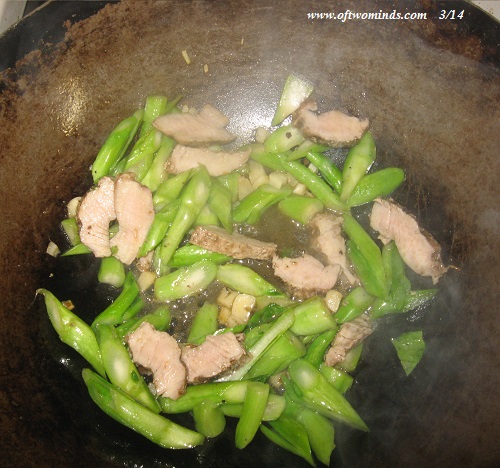
Stir-fried dishes are fairly forgiving; you don't have to get too exacting in how you cut the leaves. Add the rest of the vegetables and continue stirring until they're tender (not overcooked, not undercooked). You may need to add a bit more cooking wine or fish sauce, depending on the quantity of veggies.
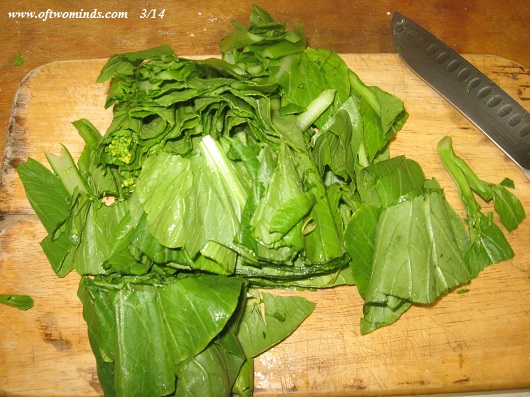
Here's the finished dish, ready to serve with whatever kind of rice you favor: basmati, jasmine, short-grain, brown, etc. If you start the rice pot (or pressure cooker, in the case of brown rice) when you begin prepping the veggies, the rice will be ready when your dish is done.
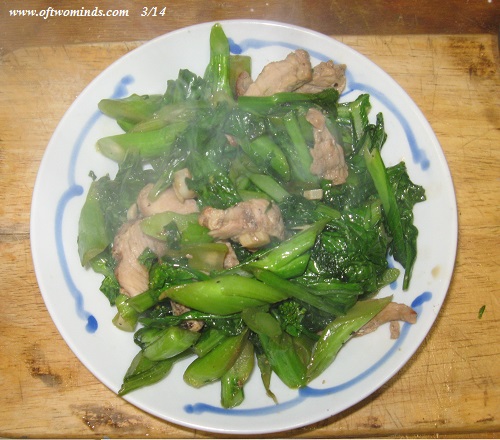
This dish meets all the requirements of healthy, high cuisine. It has a nuanced balance of flavors, textures and colors.
And it required only one pan, a seasoned wok which only needs to be rinsed, one burner and one knife.
Two fast-food "value meals" cost $12 (and leave you feeling ill), two servings at a Chinese restaurant costs $15, and this home-made meal costs a few dollars: so which one is the most affordable as well as the healthiest? If we consider cooking a form of mind-clearing positive activity, then the benefits extend beyond price and nutrition.
Depending on what's on sale (or in the bargain bin), this dish can accommodate any number of vegetables--though attention must be paid to cook them separately according to their toughness/tenderness. Here's a version that includes eggplant, red and green peppers, green onions, and bean sprouts (added at the end to maintain their crispness):
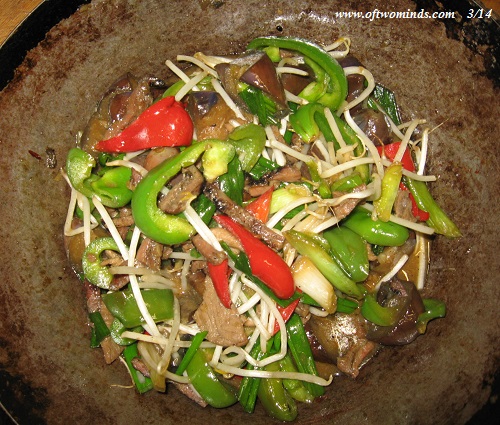
One pan, one knife, one burner, and nearly infinite variety. If this is "poor," give me another serving, please.
The Nearly Free University and The Emerging Economy:
The Revolution in Higher Education
Reconnecting higher education, livelihoods and the economyWith the soaring cost of higher education, has the value a college degree been turned upside down? College tuition and fees are up 1000% since 1980. Half of all recent college graduates are jobless or underemployed, revealing a deep disconnect between higher education and the job market.
It is no surprise everyone is asking: Where is the return on investment? Is the assumption that higher education returns greater prosperity no longer true? And if this is the case, how does this impact you, your children and grandchildren?
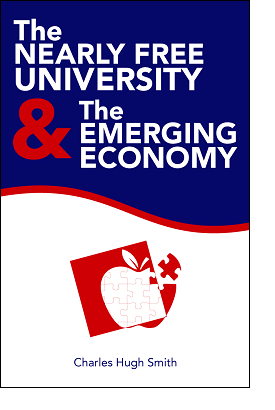
We must thoroughly understand the twin revolutions now fundamentally changing our world: The true cost of higher education and an economy that seems to re-shape itself minute to minute.
The Nearly Free University and the Emerging Economy clearly describes the underlying dynamics at work - and, more importantly, lays out a new low-cost model for higher education: how digital technology is enabling a revolution in higher education that dramatically lowers costs while expanding the opportunities for students of all ages.
The Nearly Free University and the Emerging Economy provides clarity and optimism in a period of the greatest change our educational systems and society have seen, and offers everyone the tools needed to prosper in the Emerging Economy.
Read Chapter 1/Table of Contents
print ($20) Kindle ($9.95)
Things are falling apart--that is obvious. But why are they falling apart? The reasons are complex and global. Our economy and society have structural problems that cannot be solved by adding debt to debt. We are becoming poorer, not just from financial over-reach, but from fundamental forces that are not easy to identify. We will cover the five core reasons why things are falling apart:
 1. Debt and financialization
1. Debt and financialization2. Crony capitalism
3. Diminishing returns
4. Centralization
5. Technological, financial and demographic changes in our economy
Complex systems weakened by diminishing returns collapse under their own weight and are replaced by systems that are simpler, faster and affordable. If we cling to the old ways, our system will disintegrate. If we want sustainable prosperity rather than collapse, we must embrace a new model that is Decentralized, Adaptive, Transparent and Accountable (DATA).
We are not powerless. Once we accept responsibility, we become powerful.
Read the Introduction/Table of ContentsKindle: $9.95 print: $24
| Thank you, John M. ($5/month), for your exceptionally generous re-subscription to this site -- I am greatly honored by your steadfast support and readership. | Thank you, James K. ($5/month), for your wondrously generous subscription to this site -- I am greatly honored by your support and readership. |


